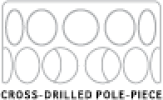

Корпусной сабвуфер с одним НЧ-динамиком 12W7AE-3, 750 Вт, 3 Ом
SKU 93271 | Model CLS112RG-W7AE
купить в магазине








Корпусной сабвуфер с одним НЧ-динамиком 12W7AE-3, 750 Вт, 3 Ом, закрытый корпус, покрытие – черный карпет
Эталонный 300-мм (12") сабвуфер 12W7AE-3 в корпусе закрытого типа – готовое предложение для тех, кто выбирает только лучшее из лучших. Остается подключить достойный басовый усилитель, чтобы услышать воплощенную мечту: глубокий предельно точный подвижный бас, принесший JL Audio и старшей серии W7AE признание по всему миру. Высшее качество звучания сочетается с внушительным запасом по подводимой мощности: этот сабвуфер легко справляется с самыми сложными музыкальными задачами. Изготовленный по технологии V-Groove корпус имеет тщательно просчитанные и проверенные в реальных условиях характеристики для полного раскрытия выдающегося потенциала НЧ-динамика. Преимущества V-Groove с высокоточной обработкой элементов конструкции корпуса из панелей MDF на станках с ЧПУ и последующим патентованным способом их скрепления друг с другом приносят значительный рост жесткости и герметичности по сравнению с традиционной конструкцией. Для упрощения установки (например, за спинкой заднего сиденья) задняя стенка корпуса выполнена наклонной, тогда как его габариты остаются весьма умеренными для данного типоразмера НЧ-динамика.
Корпус покрыт высококачественным немарким черным карпетом, глянцевая ламинированная фронтальная панель содержит крупный логотип JL Audio. Динамик надежно защищен тремя прочными алюминиевыми дугами.
- Допустимая продолжительная мощность (RMS)
- 1000 W
- Номинальное сопротивление динамика
- 3 Ω
- Тип корпуса
- Sealed, rear-firing design
- Внешний вид
- Black carpet / laminate
- Защитный гриль в комплекте
- Aluminum Bar Grille
- Ширина корпуса (внешняя, W)
- 21.25 in / 540 mm
- Высота корпуса (внешняя, H)
- 16.50 in / 419 mm

- Внешняя глубина (D1)
- 17 in / 432 mm
- Общая глубина (D2)
- 11.25 in / 286 mm
- Вес
- 81.7 lb / 37.10 kg
V-Groove MDF Construction

V-Groove MDF Construction
Summary:
This advanced cabinet-building technique uses CNC-machining to create precise panel joints that make enclosure assembly more efficient and exact.
Detailed Information:
We begin with quality medium-density fiberboard, which is then machined on our CNC-controlled KOMO woodworking stations. These powerful machines are able to cut a wide range of features onto a sheet of MDF, with minimal waste and absolute precision. The KOMO machines cut out the woofer holes, terminal holes, cut dado grooves, create countersinks and most importantly, cut the angles at the edges of the panels that form the enclosure's main shell so that these panels fit together precisely, with no gaps or leaks.
Once the panels are cut, assembly technicians line them up in the correct order and glue their outer faces onto a long piece of carpet, creating a "wrap": a long series of panels, hinged temporarily by the carpet. In the next assembly step, our wood assembly teams fill the V-grooves between the panels and any dado grooves that receive dividers or secondary wraps with wood-glue. Once the glue is applied, the enclosure shells folds together along the V-grooves, capturing dividers in the dado grooves and secondary wraps, and evenly spreading the glue throughout the joints. One line of mechanical fasteners is applied to hold the structure together while the wood glue dries.
The V-groove technique greatly improves assembly efficiency, and also results in a far stronger and better sealed enclosure than the typical butt-joint construction found on imported enclosures. The quality of the MDF used in JL Audio systems is also vastly better than the typical "China-Grade MDF" used in the imported products.
Dynamic Motor Analysis (DMA) – динамический анализ для оптимизации магнитной системы громкоговорителя

Dynamic Motor Analysis (DMA) – динамический анализ для оптимизации магнитной системы громкоговорителя
Суть вопроса:
Система Dynamic Motor Analysis (DMA) представляет собой мощное программное обеспечение, моделирующее электромагнитные процессы по методу конечных элементов (Finite Element Analysis – FEA) разработанное и впервые представленное JL Audio в 1997, чтобы научно решить проблему линейности динамиков. Использование усовершенствованной с годами системы DMA при проектировании динамиков позволяет значительно снизить искажения и улучшить переходные характеристики… или, проще говоря, получить плотный, неискажённый артикулированный бас.
Подробная информация:
Начиная с 1997 года JL Audio является лидирующей компанией, разрабатывающей элементы подвеса и магнитной системы динамиков с использованием моделирования по методу конечных элементов. Целью этих исследований является расшифровка “геномома громкоговорителя”, понимание и оценка его реального поведения в движении при подаче на динамик реального сигнала определённой мощности. Основным компонентом этой интегрированной системы моделирования является DMA (Dynamic Motor Analysis). Начиная с модели 15W3 и сабвуферов серии W7 в конце 1990-х и начале 2000 х годов, анализ DMA сыграл важную роль в формировании дизайна всех громкоговорителей JL Audio, включая наши компонентные акустические системы.
DMA – это система анализа на основе метода конечных элементов (Finite Element Analysis – FEA), это означает, что она берёт большую комплексную задачу, разбивает ее на небольшие элементы для анализа, а затем собирает данные для формирования “общей картины” точного решения. Технологический прорыв DMA заключается в том, что он фактически учитывает взаимное влияние подводимого к катушке мощного сигнала и положение катушки/диффузора динамика в рамках анализа во временной области. Это дает нам очень точную модель фактического поведения динамика при подаче на него сигнала с реальной мощностью, чего не могут сделать традиционный метод Тиля-Смолла или другие измерения параметров на низкой мощности. Поскольку DMA анализирует не стационарную модель, можно изменять параметры схемы в поисках оптимальных параметров. Процесс моделирования происходит в течение длительного периода времени для каждого динамика.
DMA способен анализировать реальные эффекты колебания мощности и при перемещении катушки относительно магнитной системы динамика, в частности динамические изменения “фиксированного” магнитного поля. Это дает чрезвычайно ценную информацию по сравнению с традиционным моделированием, которое для простоты расчета предполагает, что так называемое “фиксированное” магнитное поле, создаваемое в зазоре звуковой катушки неизменно. DMA не только показывает, что это “фиксированное” поле на самом деле изменяется из-за влияния магнитного поля, создаваемого током, протекающим через звуковую катушку, но и помогает нашим инженерам найти решения, которые минимизируют эту нестабильность. Анализ этого поведения имеет решающее значение для понимания механизмов возникновения нелинейных искажений в моторе динамика и проливает свет на аспекты конструкции магнитной системы, которые определяют его линейность:
- Линейность силы магнитной системы в рабочем диапазоне перемещения подвижной системы громкоговорителя
- Постоянство силы магнитной системы с обоими величинами тока проходящего через звуковую катушку – положительной и отрицательной
- Постоянство сила магнитной системы при различных уровнях мощности подводимого сигнала
Применение системы DMA позволяет нашим инженерам электроакустикам вносить критические изменения в конструкцию и создавать динамики с линейными и высокостабильными магнитными системами.
Любой динамик произведенный компанией JL Audio обладает пониженным уровнем искажений, улучшенными переходными характеристиками и превосходным качеством звучания.
W-Cone – W-диффузор громкоговорителя (защищено патентом U.S. #6,496,590)

Суть вопроса:
W-Cone - это конструкция узла диффузора и технология его сборки, которые обеспечивают сочетание его небольшой массы и необычайной жесткости. Форма элементов диффузора также определяет его исключительную жесткость на скручивание, которая критична для правильного расположения катушки в крайних положениях хода динамика.
Подробная информация:
Чем больше сила магнитного поля и ход подвижной системы динамика, тем важнее становится жесткость диффузора. Силы ускорения экстремальны, требуется, чтобы диффузор выдерживал перегрузки и быстрые изменения направления движения без деформации. Деформация не только приводит к искажениям, но также может влиять на механическую целостность динамика, позволяя звуковой катушке выйти из рабочего положения и механически контактировать с верхним фланцем и полюсным наконечником магнита.
Существует несколько подходов к повышению жесткости диффузора. Самые очевидные – использование более толстого и/или более жёсткого материала. В последние годы несколько производителей использовали композитные (на основе Kevlar®, стекловолокна и т.д.), или металлические (алюминий, магний, титановые сплавы) материалы диффузора. Использование этих экзотических материалов обычно сопровождается маркетинговыми утверждениями о том, что выбранный материал обладает исключительными характеристиками соотношения жесткости по отношению к массе. Эти утверждения истинны, но они могут вводить в заблуждение. В то время как сами по себе эти материалы обладают отличными характеристиками соотношения жесткости по отношению к массе (по сравнению с целлюлозой или полипропиленом), на практике диффузоры из этих материалов не легче диффузоров из целлюлозы или полипропилена. Это означает, что их использование допускает компромиcс, который приводит к увеличению массы подвижной системы в конструкции. Плата за этот компромисс – снижение эффективности и усложнение подвеса (поскольку сложнее удерживать более тяжелый диффузор в нужном положении).
Классический диффузор из полипропилена обладает достаточной жесткостью для конструкций с меньшей мощностью, но его жёсткости недостаточно для требований предъявляемой к конструкции сабвуфера серии W7. Наша команда инженеров сконцентрировалась на разработке очень жёсткого диффузора, но при этом без значительного увеличения его массы. Эти усилия в конечном итоге привели к появлению дизайна, который мы называем W-Cone. Жесткость узла диффузора W-Cone достигается с помощью архитектурных методов расчета прочности, а не за счет применения
изначально жестких материалов. В основе конструкции диффузора W-Cone две легкие полипропиленовые детали с минеральным наполнением, которые соединяются вместе по периметру и в центре сборки. Нижняя деталь в сечении имеет форму буквы “W”, отсюда и название, и обеспечивает невероятную жесткость при соединении с верхней частью. Эффект примерно такой же как при сборке отдельных ферм моста или сварке отдельных кузовных элементов современного автомобиля в единую прочную структуру. В дополнение к увеличению общей жесткости, нижний элемент конструкции распределяет силу, создаваемую звуковой катушкой и магнитной системой, более равномерно, чем в случае классического диффузора. Сила прилагается не только к вершине конуса, но также распределена по периметру внешней диафрагмы для более линейного поведения. Еще одним преимуществом W-Cone является то, что непосредственно излучающая поверхность диффузора (которая контактирует со средой прослушивания) изолирована от непосредственного влияния высокого давления воздуха с обратной стороны диффузора, что дополнительно уменьшает её деформацию (и, следовательно, и искажения).
Для сравнения: W-Cone диффузор сабвуфера 12W7 на 32% легче обычного 12-дюймового диффузора из алюминиевого сплава. Если проанализировать с точки зрения веса на квадратный дюйм площади диффузора, у сабвуферов серии W7 он весит 1,24 г / кв. дюйм, по сравнению с 1,45 г / кв. дюйм для диффузора из алюминиевого сплава и 1,66 г / кв. дюйм для диффузора из титанового сплава.
Так почему полипропилен? Как указано выше, наша запатентованная технология W-Cone обеспечивает все преимущества более экзотических материалов, в то же время свойства полипропилена имеют ряд преимуществ с учетом уникальной конструкции сабвуферов серии W7. Поскольку внешний подвес сабвуферов W7 является съемным, подвижная система (включая диффузор) может подвергаться
механическим воздействиям, которые не встречаются в обычных конструкциях. Диффузор должен быть устойчив к деформациям и повреждениям, поскольку пользователь может перекосить его при манипуляциях с подвесом, которые необходимы для физического крепления сабвуфера W7 к корпусу. Целлюлозные, металлические или хрупкие композитные диффузоры не соответствуют этим повышенным требованиям. Диффузор из полипропилена, выполненный по технологии W-Cone, имеет превосходную осевую и торсионную жёсткость (на скручивание) и выдержит любые нагрузки.
Elevated Frame Cooling (U.S. Patent #6,219,431 & #6,229,902)

Elevated Frame Cooling (U.S. Patent #6,219,431 & #6,229,902)
Summary:
JL Audio's patented Elevated Frame Cooling design delivers cool air through slots directly above the top-plate to the voice coil of the speaker. This not only enhances power handling, but also sound quality by minimizing dynamic parameter shifts and power compression.
Detailed Information:
Many speakers employ venting techniques to enhance voice coil cooling. This is typically accomplished by having big holes in the sides of the frame just below the spider attachment shelf. While it provides a modest cooling benefit, this low-velocity air-flow does not blow directly or strongly on the voice coil.
Our patented design improves upon this cooling technique in a number of ways. By elevating the frame above the top-plate of the motor (via stand-offs integrated into the bottom of the frame) a narrow, high-velocity air-path is created between the bottom surface of the frame and the top surface of the top-plate. This air path leads directly to the voice coil and then turns upward into the spider air cavity. By utilizing the pumping action of the spider through this focused air path, a large volume of cool air hits the coil windings directly.
Another important benefit is that the upper surface of the top-plate (one of the speaker's hottest parts) is directly exposed to cooling air flow, whereas on a conventional design it is isolated from the air flow by the lower flange of the frame. The elevated frame technology greatly increases thermal power handling, reduces compression effects and does so without any additional parts.
Floating Cone Attach Method - FCAM™ (U.S. Patent #6,501,844)

Floating Cone Attach Method - FCAM™ (U.S. Patent #6,501,844)
Summary:
This assembly technique, conceived by JL Audio, ensures proper surround geometry in the assembled speaker for better excursion control and dynamic voice coil alignment.
Detailed Information:
JL Audio's patented FCAM™ technology is an innovative method of bonding the surround/cone assembly to the voice coil former/spider assembly. This feature helps ensure concentricity of the surround, spider and voice coil without torquing the suspension to achieve it. This allows for the inevitable, slight variations in production part dimensions without having them negatively impact the integrity of the suspension and coil-centering at high excursions.
OverRoll™ Surround (U.S. Patent #5,687,247 & #5,949,898)

OverRoll™ Surround (U.S. Patent #5,687,247 & #5,949,898)
Summary:
By utilizing space wasted in conventional speakers, this ground-breaking innovation controls the W7's massive excursion without sacrificing precious cone area.
Detailed Information:
One of the first things you notice about a W7 is that something is "missing"... the mounting flange. Of course, this is actually not the case. The mounting flange is simply hidden beneath the surround and is made accessible for mounting purposes by detaching the outer edge of the surround and moving the roll to the inside (a pretty neat little trick). Apart from the obvious benefits of amazing your friends as you pull the surround off your speaker, there is a serious technical issue that led us in this design direction: Effective Piston Area ("Sd"). This is essentially the speaker's "cylinder bore", to use an automotive engine analogy, and is calculated by measuring the diameter of the diaphragm including one-half of the surround roll-width. In other words, from the top-center of the surround on one side to top-center of the surround on the other side.
The displacement capability of a speaker is determined by this piston area times the speaker's excursion capability. Displacement of air is directly linked to output potential. Therefore, the more air a speaker can ultimately displace, the louder it can play. That being said, there is a big difference between piston area and excursion: piston area doesn't need power to make it happen. This means that by making a larger piston, you are directly improving displacement for a given amount of excursion and, therefore, making your speaker more efficient. This is not the only factor that governs efficiency, but it is a major one.
To make a speaker have more excursion capability not only requires a motor design that can deliver more stroke, but also requires a surround rugged enough to handle the demands of longer excursions and controlled enough to keep everything lined up properly. If the surround's roll-width is not adequately large, its behavior (compliance) is not linear over the useful stroke of the woofer and it is more likely to fatigue and fail. For this reason, speakers with longer excursion capability generally need larger surround rolls (we won't comment on the ones that use large rolls strictly for cosmetic effect).
The problem with big surrounds is that they begin to encroach on the effective piston area of the driver. For example, a typical 12-inch woofer with a medium-sized roll has an effective piston area of 81.52 square inches. Compare this to a fat-surround 12-inch woofer which has a piston area of 69.07 square inches (15.2 % less effective piston area than the medium-size roll.) To overcome this loss, the fat-surround woofer has to produce more excursion to displace the same air as the woofer with the medium surround (and will require more power to do so).
OverRoll™ technology neatly sidesteps this compromise by allowing us to make full use of the entire footprint of the speaker, placing the surround further to the outside than in a conventional woofer. This means that we can use a large roll for all its benefits without sacrificing cone area (in fact, the 12W7 has 1% more piston area than the medium-surround conventional woofer). By maximizing the effective piston/total footprint ratio, we can deliver more output for a given excursion and outside frame diameter. This means that the prodigious excursion advantage of the W7 can be put to full use enhancing output, rather than making up for lost piston area.
The technology also provides a geometry advantage on the outside edge of the surround roll, allowing for more linear operation. A further benefit is that the mounting holes are inherently sealed by the surround, resulting in an improved box seal.
Radially Cross-Drilled Pole-Piece (U.S. Patent #6,243,479)

Radially Cross-Drilled Pole-Piece (U.S. Patent #6,243,479)
Summary:
This innovative venting system greatly enhances thermal dissipation and power handling by directing air flow onto the voice coil former, working in conjunction with the Elevated Frame cooling technology to effectively remove heat from the voice coil. This improves power handling and reduces power compression effects, leading to more linear performance.
Detailed Information:
This technology differs from a conventionally vented pole-piece in that the air flow is capped off at the top of the pole-piece and directed through machined holes on the outer wall of the pole-piece to the region directly behind the voice coil. The top portion of the pole-piece is smaller in outside diameter where the holes vent and helps create a high-volume, high-velocity airflow path between the inner-coil cavity and the ambient air of the enclosure.This helps remove super-heated air that is trapped between the coil former and pole-piece on a conventional design, leading to a dramatic improvement in cooling efficiency, especially at high excursions.
Engineered Lead-Wire System (U.S. Patent #7,356,157)

Engineered Lead-Wire System (U.S. Patent #7,356,157)
Summary:
Carefully engineered lead-wire design and attachments ensure controlled, quiet lead-wire behavior under the most extreme excursion demands.
Detailed Information:
Managing the lead-wires on a long-excursion woofer is one of the trickier aspects of its mechanical design. To address this, many long-excursion woofers today rely on a simple solution that weaves the lead-wires into the spider (rear suspension) of the driver.
The biggest problem with this approach is that spider limiting behavior plays a hugely important role a woofer's performance. Lead-wires that are attached or woven into the spider material can alter the spider's "stretching" behavior. The tinsel wire naturally has less 'give' than the fabric material of the spider leading to asymmetrical spider behavior and non-uniform stress distribution around the spider circumference. The wire attachment points can also cause localized pulling and tearing forces at the spider's excursion limits. As such, longevity becomes a major concern and makes the woven-in design less than ideal for very long-excursion designs.
While a traditional 'flying lead' design does not compromise spider linearity or radial stability, it creates its own challenges on a long-excursion woofer. Managing the 'whipping' behavior of the wire and making sure it does not contact the cone or spider is one challenge. Another is ensuring that the leads do not short one another or the frame of the woofer.
To overcome these issues, JL Audio's engineered flying lead-wires work in conjunction with carefully engineered entry and exit support structures molded into the terminals and the voice coil collar. Some models also feature jacketed lead-wires to further reduce the likelihood of shorting and fatigue. The result is flawless high-excursion lead-wire behavior, with outstanding reliability and none of the compromises inherent to a woven-in lead wire system. Building woofers this way requires much more labor and parts complexity than the simpler woven-in approach, but the payoff is in reduced distortion, reduced mechanical noise and improved reliability.
Precision Built in U.S.A.

Precision Built in U.S.A.
Summary:
JL Audio's Miramar, Florida loudspeaker production facility is one of the most advanced in the world.
Detailed Information:
At a time when most audio products are built overseas, JL Audio’s commitment to in-house loudspeaker production continues to grow. All W7’s, W6’s, TW5’s, TW3's, TW1's, W3v3’s and some of our ZR products. We also build our Marine Speaker Systems, Home Subwoofers, Stealthbox® products and the vast majority of our enclosed subwoofer systems in Florida.
To pull this off in a competitive world market, our production engineering team has created one of the world’s most advanced loudspeaker assembly facilities. This commitment to state-of-the-art technology allows our highly skilled workforce to efficiently build JL Audio products to extremely high quality standards.
While it is also feasible to build good quality products overseas (and we do build some of our products in Europe and Asia), it can be challenging when the product’s technology is innovative or complex. Since most of our premium loudspeakers incorporate proprietary, patented technologies requiring specific assembly techniques, we prefer that the people who design them have close access to the people manufacturing them.